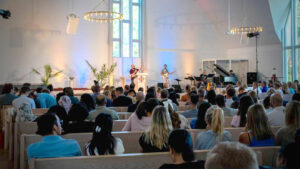For some, the gospel narrative means Jesus came to end exclusion and preach God’s inclusive kingdom. This was certainly part of his ministry and is arguably the most appealing aspect to our culture’s moral sensibilities. In Jesus, the outcasts of society have hope. Those long marginalized and kicked to the curb (figuratively and literally) can find him extending a hand, inviting them back into the community of the truly human as objects of dignity and divine affection.
Issues of inclusion and exclusion lie at the heart of our society’s most contested social issues. Whether it’s part of the dynamics underlying the racial tensions dividing our cities or our country’s heated discourse on sexuality, we need to deal with the realities of inclusion and exclusion. This is why I recently revisited Miroslav Volf’s Exclusion and Embrace: A Theological Exploration of Identity, Otherness, and Reconciliation (Abingdon, 1996). It’s a fascinating theological account of forgiveness, truth, justice, and exclusion. Volf’s account has a particular poignancy as it’s set in the context of the exclusionary violence that destroyed his own home in the Balkans.
Nuancing Inclusion
I was immediately struck by Volf’s nuanced treatment of Jesus’s ministry of inclusion—or rather, ministry against exclusion. According to some accounts of Jesus’s ministry of radical inclusion, he offered his invitations to all without requirements or prohibitions, except for those sinning by exclusion. Exclusion is the aboriginal sin. The gracious kingdom of God, therefore, eliminates any construction of binaries. Following Jesus means rolling back boundaries, deconstructing categories, and flattening every moral and social hill in light of our inclusive God.
According to Volf, though, it’s not that simple. While it’s true some of Jesus’s work included transgressing “social boundaries that excluded the outcasts, demonstrating that these boundaries themselves were evil, sinful, and outside of God’s will” (72), Volf writes:
It would be a mistake . . . to conclude from Jesus’s compassion toward those who transgressed social boundaries that his mission was merely to demask the mechanisms that created “sinners” by falsely ascribing sinfulness to those who were considered socially unacceptable. He was no prophet of “inclusion” . . . for whom the chief virtue was acceptance and the cardinal vice intolerance. Instead, he was a bringer of “grace,” who not only scandalously included “anyone” in the fellowship of “open commensality,” but made the “intolerant” demand of repentance and the “condescending” offer of forgiveness (Mark 1:15; 2:15–17). The mission of Jesus consisted not simply of renaming the behavior that was falsely labeled “sinful” but also in remaking the people who have actually sinned and suffered distortion. The double strategy of renaming and remaking, rooted in the commitment to both the outcast and the sinner, to the victim and the perpetrator, is the proper background against which an adequate notion of sin as exclusion can emerge. (72–73)
Grasping this duality of renaming and remaking is vital if we’re going to follow Jesus well and think rightly about what being an inclusive church really means. So what does Volf say about these two components of Jesus’s ministry?
Renaming
First, he tackles the issue of renaming. When Jesus declares all foods clean (Mark 7:14–23), or heals the bleeding woman (Mark 5:25–34), or teaches the inclusion of Gentiles into the kingdom, he ends boundaries that place people in categories of clean and unclean: “By the simple act of renaming, Jesus offset the stark binary logic that regulates so much of social life: society is divided into X (superior in-group) and non-X (inferior out-group)” (73). Jesus upsets a false system of exclusion—one that divided people he was equalizing and bringing into the mutual community of the clean.
Something’s missing from Volf’s analysis, though: the dual dimension in which Jesus’s work of renaming functions. His renaming often works at the simultaneous level of correction and covenantal dispensation. Jesus aimed some of his acts of renaming at correcting distortions within the rabbinic and pharisaic halakhah, which aggravated the exclusivism inherent in the ceremonial law of Torah. (This type of exclusivism inevitably continues to happen in almost every church situation.) But other acts of renaming declared clean what was ritually unclean under the old covenant. Previous distinctions (Jew and Greek, kosher, and so on) had served their purpose in pointing to Christ and were now over in the new covenant age. Jesus renames the distinctions as covenantally irrelevant (Acts 10:5).
Remaking
What about the issue of remaking? “In addition to removing the label ‘unclean’ placed on the things that were clean,” Volf observes, “Jesus made clean things out of truly unclean things” (73). Jesus casted out unclean, sinful, tormenting spirits that held people captive and caused behaviors that excluded them from community (Mark 5:1–20). But he also dealt with “people caught in the snares of wrongdoing”:
People who, like tax-collectors, harm others in order to benefit themselves; people who, like prostitutes, debase themselves in order to prosper or just survive; people who, like most of us, are bend on losing their own souls in order to gain a bit of the world—such people were forgiven and transformed. (73)
In other words, Jesus ended their exclusion with a grace that acknowledged a self-excluding condition, habit, disposition, or behavior that needed regeneration and forgiveness. Indeed, forgiveness is an including act that inherently contains an act of condemnation. But Jesus doesn’t just simply rename evil as good or indifferent—he tackles it head-on by destroying its roots in the human heart.
This is the more fundamental dimension of Jesus’s ministry of inclusion. Many suffer from regimes of unjust exclusion on the basis of gender, socio-economics, race, or stigma attached to a mental disorder. Therefore, we should praise God that Jesus offers hope and commands us to proclaim that social divisions are obliterated in Christ (Gal. 3:28; 1 Cor. 11). But not everyone was—or is now—in a situation needing to be renamed. That said, we all fall short of the glory of God and exclude ourselves from communion with God (Rom. 3:23; 6:23), and so we all need Jesus to remake—reconcile—us through the power of his blood. Everyone—rich and poor, black and white, male and female, Jew and Gentile—needs Christ’s ministry of remaking in their lives. Indeed, one of the main ways Jesus and the apostles undermined systems of exclusion built on false social categorizations was through a shared new name that signaled a shared new heart. Christians move from being together “in Adam” together to being together “in Christ.”
Two Kinds of Inclusion
I fear a failure to appreciate or apply the distinction between renaming and remaking in the church’s call to practice inclusion lies at the heart of so many of our hottest disputes. The dispute on human sexuality is burning particularly hot right now.
Progressives too often paint it as a debate between those who truly understand Jesus’s radical message of inclusion and those want to hold onto the old, exclusionary binaries of the Pharisees and Judaizers. We get to pick between being those who want to exclude and those who want to include—and how fun is it to play Jesus versus the Pharisees, right? Volf’s categories, however, show a more appropriate question: what is the method of inclusion that applies in this situation? While progressives see a situation of renaming akin to the Gentiles, the church has traditionally seen a situation of remaking (which, connected to sexuality, needs careful parsing—don’t read certain psychological programs into my use of the term). Still, according to the historic position, renaming would mean calling evil good.
This is where the irony enters. Traditionalists are often accused of being gatekeepers trying to keep people out of God’s kingdom. But if they are right—if treating sexual behavior like one of those outmoded sinful categories is a mistake—then ultimately the danger is that people won’t be called to repent from the kinds of behaviors that Christ and his apostles say lead to self-exclusion from the kingdom of God. It’s precisely the traditionalists’ desire to include people in the kingdom that drives their opposition to the wrong sort of inclusion. It’s precisely because they hate the idea of seeing anyone excluded from the kingdom of God that they insist we not offer inclusion on false premises.
One Way
In the end, it’s like two locals telling a visitor how to get into a building. One tells the visitor he must go through the main gate, while the other says to go through an easier side door. The latter fears the main gate is too far away and too hard to enter. Initially, this local appears to make it easier for the visitor to get in, while the other seems to impose a harsher standard—until you find out there’s no side door.
While the easier instruction is well intended, it’s sadly just another way of keeping the visitor out.
Download your free Christmas playlist by TGC editor Brett McCracken!
 It’s that time of year, when the world falls in love—with Christmas music! If you’re ready to immerse yourself in the sounds of the season, we’ve got a brand-new playlist for you. The Gospel Coalition’s free 2025 Christmas playlist is full of joyful, festive, and nostalgic songs to help you celebrate the sweetness of this sacred season.
It’s that time of year, when the world falls in love—with Christmas music! If you’re ready to immerse yourself in the sounds of the season, we’ve got a brand-new playlist for you. The Gospel Coalition’s free 2025 Christmas playlist is full of joyful, festive, and nostalgic songs to help you celebrate the sweetness of this sacred season.
The 75 songs on this playlist are all recordings from at least 20 years ago—most of them from further back in the 1950s and 1960s. Each song has been thoughtfully selected by TGC Arts & Culture Editor Brett McCracken to cultivate a fun but meaningful mix of vintage Christmas vibes.
To start listening to this free resource, simply click below to receive your link to the private playlist on Spotify or Apple Music.


































